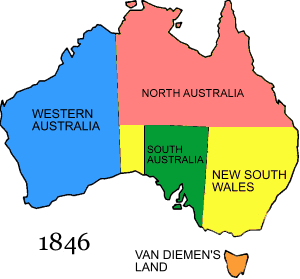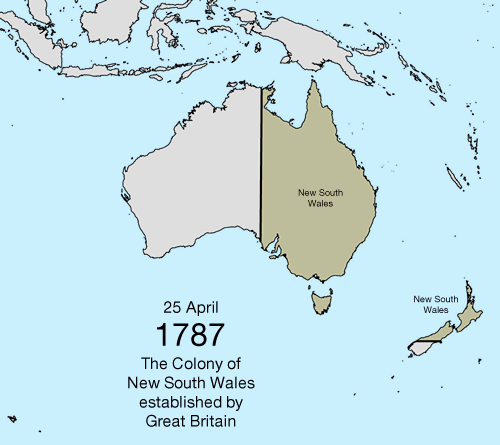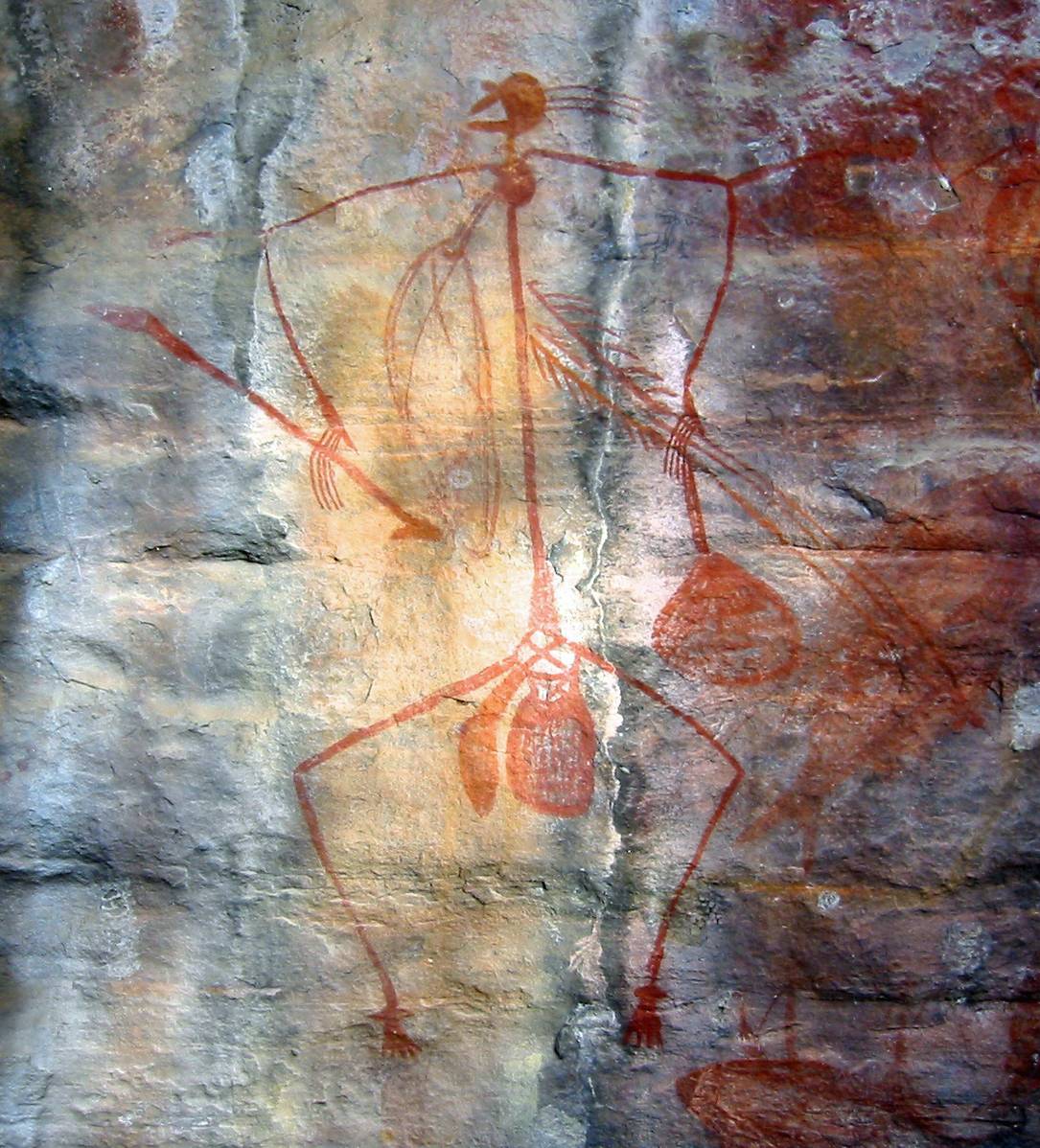|
North Australia (territory)
North Australia can refer to a short-lived former British colony, a former federal territory of the Commonwealth of Australia, or a proposed state which would replace the current Northern Territory. Colony (1846–1847) A colony of North Australia existed briefly after it was authorised by letters patent of 17 February 1846. The colony comprised all land in the Northern Territory and the present state of Queensland lying north of the 26th parallel. The capital was at Port Curtis, now called Gladstone, under Colonel George Barney as Lieutenant-Governor and Superintendent. Charles Augustus FitzRoy, the Governor of New South Wales, was Governor. The colony was proclaimed at a ceremony at Settlement Point on 30 January 1847. The establishment of the new colony, and its status as a penal colony, attracted much criticism in the New South Wales Legislative Council. The Letters Patent establishing the colony were revoked in December the same year, after a change of government in ... [...More Info...] [...Related Items...] OR: [Wikipedia] [Google] [Baidu] |
Northern Territory
The Northern Territory (commonly abbreviated as NT; formally the Northern Territory of Australia) is an states and territories of Australia, Australian territory in the central and central northern regions of Australia. The Northern Territory shares its borders with Western Australia to the west (129th meridian east), South Australia to the south (26th parallel south), and Queensland to the east (138th meridian east). To the north, the territory looks out to the Timor Sea, the Arafura Sea and the Gulf of Carpentaria, including Western New Guinea and other islands of the Indonesian archipelago. The NT covers , making it the third-largest Australian federal division, and List of country subdivisions by area, the 11th-largest country subdivision in the world. It is sparsely populated, with a population of only 249,000 – fewer than half as many people as in Tasmania. The largest population center is the capital city of Darwin, Northern Territory, Darwin. The archaeological hist ... [...More Info...] [...Related Items...] OR: [Wikipedia] [Google] [Baidu] |
Penal Transportation
Penal transportation or transportation was the relocation of convicted criminals, or other persons regarded as undesirable, to a distant place, often a colony, for a specified term; later, specifically established penal colonies became their destination. While the prisoners may have been released once the sentences were served, they generally did not have the resources to return home. Origin and implementation Banishment or forced exile from a polity or society has been used as a punishment since at least the 5th century BC in Ancient Greece. The practice of penal transportation reached its height in the British Empire during the 18th and 19th centuries. Transportation removed the offender from society, mostly permanently, but was seen as more merciful than capital punishment. This method was used for criminals, debtors, military prisoners, and political prisoners. Penal transportation was also used as a method of colonization. For example, from the earliest days of English ... [...More Info...] [...Related Items...] OR: [Wikipedia] [Google] [Baidu] |
Territorial Evolution Of Australia
The first colonies of the British Empire on the continent of Australia were the penal colony of New South Wales, founded in 1788, and the Swan River Colony (later renamed Western Australia), founded in 1829. Over the next few decades, the colonies of New Zealand, Queensland, South Australia, Van Diemen's Land (later renamed Tasmania), and Victoria were created from New South Wales, as well as an aborted Colony of North Australia. On 1 January 1901, these colonies, excepting New Zealand, became states in the Commonwealth of Australia. Since federation, the internal borders have remained mostly stable, except for the creation of some territories with limited self-government: the Northern Territory from South Australia, to govern the vast, sparsely populated centre of the country; the split of the Northern Territory into Central Australia and North Australia, and then the quick merger of those back into the Northern Territory; and the Australian Capital Territory, a federal district ... [...More Info...] [...Related Items...] OR: [Wikipedia] [Google] [Baidu] |
States And Territories Of Australia
The states and territories are federated administrative divisions in Australia, ruled by regional governments that constitute the second level of governance between the federal government and local governments. States are self-governing polities with incomplete sovereignty (having ceded some sovereign rights to federation) and have their own constitutions, legislatures, departments, and certain civil authorities (e.g. judiciary and law enforcement) that administer and deliver most public policies and programs. Territories can be autonomous and administer local policies and programs much like the states in practice, but are still constitutionally and financially subordinate to the federal government and thus have no true sovereignty. The Federation of Australia constitutionally consists of six federated states (New South Wales, Queensland, South Australia, Tasmania, Victoria, and Western Australia) and ten federal territories,Section 2B, Acts Interpretation Act 1901 out of ... [...More Info...] [...Related Items...] OR: [Wikipedia] [Google] [Baidu] |
Central Australia
Central Australia, also sometimes referred to as the Red Centre, is an inexactly defined region associated with the geographic centre of Australia. In its narrowest sense it describes a region that is limited to the town of Alice Springs and its immediate surrounds including the MacDonnell Ranges. In its broadest use it can include almost any region in inland Australia that has remained relatively undeveloped, and in this sense is synonymous with the term Outback. Centralia is another term associated with the area, most commonly used by locals. As described by Charles Sturt in one of the earlier uses of the term "A veil hung over Central Australia that could neither be pierced or raised. Girt round about by deserts, it almost appeared as if Nature had intentionally closed it upon civilized man, that she might have one domain on the earth's wide field over which the savage might roam in freedom." In a modern, more formal sense it can refer to the administrative region used by ... [...More Info...] [...Related Items...] OR: [Wikipedia] [Google] [Baidu] |
History Of Australia
The history of Australia is the story of the land and peoples of the continent of Australia. People first arrived on the Australian mainland by sea from Maritime Southeast Asia between 50,000 and 65,000 years ago, and penetrated to all parts of the continent, from the rainforests in the north, the deserts of the centre, and the sub-Antarctic islands of Tasmania and Bass Strait. The artistic, musical and spiritual traditions they established are among the longest surviving such traditions in human history. The first Torres Strait Islanders – ethnically and culturally distinct from the Aboriginal people – arrived from what is now Papua New Guinea around 2,500 years ago, and settled in the islands of the Torres Strait and the Cape York Peninsula forming the northern tip of the Australian landmass. The first known landing in Australia by Europeans was in 1606 by Dutch navigator Willem Janszoon. Later that year, Spanish explorer Luís Vaz de Torres sailed through, and navig ... [...More Info...] [...Related Items...] OR: [Wikipedia] [Google] [Baidu] |
Northern Australia
The unofficial geographic term Northern Australia includes those parts of Queensland and Western Australia north of latitude 26° and all of the Northern Territory. Those local government areas of Western Australia and Queensland that lie partially in the north are included. Although it comprises 45% of the total area of Australia, Northern Australia has only 5% of the Australian population (1.3 million in 2019). However, it includes several sources of Australian exports, being coal from the Great Dividing Range in Queensland/New South Wales and the natural gas and iron ore of the Pilbara region in WA. It also includes major natural tourist attractions, such as Uluru (Ayers Rock), the Great Barrier Reef and the Kakadu National Park. Geography and climate Almost all of Northern Australia is a huge ancient craton that has not experienced geological upheaval since the end of the Precambrian. The only exception to this generalisation is the Wet Tropics of northern Queensla ... [...More Info...] [...Related Items...] OR: [Wikipedia] [Google] [Baidu] |
1909–1954)
Nineteen or 19 may refer to: * 19 (number), the natural number following 18 and preceding 20 * one of the years 19 BC, AD 19, 1919, 2019 Films * ''19'' (film), a 2001 Japanese film * ''Nineteen'' (film), a 1987 science fiction film Music * 19 (band), a Japanese pop music duo Albums * ''19'' (Adele album), 2008 * ''19'', a 2003 album by Alsou * ''19'', a 2006 album by Evan Yo * ''19'', a 2018 album by MHD * ''19'', one half of the double album ''63/19'' by Kool A.D. * ''Number Nineteen'', a 1971 album by American jazz pianist Mal Waldron * ''XIX'' (EP), a 2019 EP by 1the9 Songs * "19" (song), a 1985 song by British musician Paul Hardcastle. * "Nineteen", a song by Bad4Good from the 1992 album ''Refugee'' * "Nineteen", a song by Karma to Burn from the 2001 album ''Almost Heathen''. * "Nineteen" (song), a 2007 song by American singer Billy Ray Cyrus. * "Nineteen", a song by Tegan and Sara from the 2007 album '' The Con''. * "XIX" (song), a 2014 song by Slipknot. ... [...More Info...] [...Related Items...] OR: [Wikipedia] [Google] [Baidu] |
Federal Register Of Legislation
The Office of Parliamentary Counsel (OPC) is an Australian Commonwealth government agency established under the ''Parliamentary Counsel Act 1970'' (Cth) within the Commonwealth Attorney-General's portfolio. OPC drafts all government Bills that are introduced into the federal Parliament, legislative instruments made by the Governor-General, and a range of other delegated legislation. It also manages the Federal Register of Legislation (the ''Legislation'' ''Register'') to provide access to authorised, up-to-date versions of Commonwealth laws. OPC was established in 1970 and is currently led by Meredith Leigh, First Parliamentary Counsel. History Arrangements for the drafting of Commonwealth legislation were put in place at the very beginning of Australia's federation as a nation in 1901. Originally, the Secretary to the Attorney-General's Department was the Parliamentary Draftsman, with a separate position not created until 1946. By 1954, a Parliamentary Drafting Division had ... [...More Info...] [...Related Items...] OR: [Wikipedia] [Google] [Baidu] |
Central Australia (territory)
Central Australia was a territory of Australia that existed from 1927 to 1931. It was formed from the split of the Northern Territory in 1927 alongside the territory of North Australia; the dividing line between the two was 20 degrees south latitude. The two territories were merged in 1931 to reform the Northern Territory. Central Australia's seat was in Stuart, which was known commonly, and has been officially since 1933, as Alice Springs. Background The split occurred because interior minister George Pearce felt that the Northern Territory was too big to govern efficiently, and was part of Pearce's plan to create a specialised commission to develop Australia north of the 20th parallel. It occurred on 1 March 1927. Government Whereas the Northern Territory had been governed by an Administrator, both North Australia and Central Australia were governed by Government Residents. The Government Resident of Central Australia was paid £750 annually while the Resident of North Aust ... [...More Info...] [...Related Items...] OR: [Wikipedia] [Google] [Baidu] |
Minister For Home Affairs (Australia)
The Minister for Home Affairs in the Government of Australia is the minister responsible for the Department of Home Affairs, the country's interior ministry. The current minister is Clare O'Neil of the Labor Party, who has held the position since 1 June 2022 in the Albanese ministry. The current Department of Home Affairs was created in December 2017. The first department with that name was created in 1901, as one of the original six departments created at Federation, and was responsible for a wide range of areas not captured by the other departments. Similar departments have existed in almost all subsequent governments, under several different names. The specific title "Minister for Home Affairs" has been created six times – in 1901, 1929, 1977, 1987, 2007 and 2017. History The Minister for Home Affairs was a ministerial portfolio that existed continuously from 1901 to 12 April 1932, when Archdale Parkhill became Minister for the Interior in the first Lyons Ministry— ... [...More Info...] [...Related Items...] OR: [Wikipedia] [Google] [Baidu] |
George Pearce
Sir George Foster Pearce KCVO (14 January 1870 – 24 June 1952) was an Australian politician who served as a Senator for Western Australia from 1901 to 1938. He began his career in the Labor Party but later joined the National Labor Party, the Nationalist Party, and the United Australia Party; he served as a cabinet minister under prime ministers from all four parties. Pearce was born in Mount Barker, South Australia. He left school at the age of 11 and trained as a carpenter, later moving to Western Australia and becoming involved in the union movement. He helped establish the Labor Party there, and in 1901 – aged 31 – was elected to the new federal parliament. Pearce was elevated to cabinet in 1908, under Andrew Fisher, and served in each of Fisher's three governments. He continued on in cabinet when Billy Hughes became prime minister in 1915, and after the Labor Party split of 1916 followed Hughes to the National Labor Party and then to the Nationalists. Pearce also ... [...More Info...] [...Related Items...] OR: [Wikipedia] [Google] [Baidu] |






